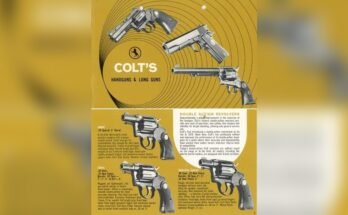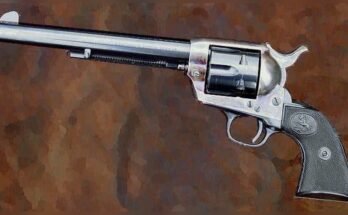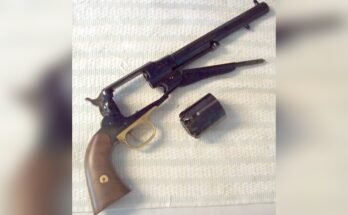Have you ever wondered what makes a revolver work so smoothly every time you pull the trigger? Understanding the different parts of a revolver can give you a clearer picture of how this classic firearm operates.
Whether you’re new to firearms or just curious, knowing these key components will help you appreciate the design and function behind every shot. Keep reading, and you’ll discover how each part plays a crucial role in making your revolver reliable and effective.
Basic Structure Of A Revolver
The basic structure of a revolver is simple yet effective. It consists of several key parts that work together to fire bullets safely and accurately. Understanding these parts helps you know how a revolver functions. Each part has a specific role in the mechanism of the gun.
A revolver’s design has stayed mostly the same for many years. This is because it balances reliability and ease of use. The main components include the frame, cylinder, barrel, and trigger. Each part must fit perfectly for the revolver to work well.
Frame
The frame is the main body of the revolver. It holds all other parts together. The frame supports the barrel and the cylinder. It also includes the grip, where the shooter holds the gun.
The cylinder is a rotating part that holds bullets. It usually has six chambers, but some have more or fewer. The cylinder turns to align each bullet with the barrel. This allows the revolver to fire multiple shots without reloading each time.
The barrel is the long metal tube where the bullet travels when fired. It guides the bullet and helps improve accuracy. The inside of the barrel is rifled with grooves that spin the bullet for better flight.
The trigger is the part you pull to fire the revolver. Pulling it releases the hammer or firing pin. This strikes the bullet’s primer, causing it to fire. The trigger also controls the timing of the cylinder rotation.
Frame And Grip
The frame and grip are key parts of a revolver. The frame is the main body. It holds all other parts together. The grip is where the shooter holds the revolver. Both affect how the revolver feels and works. Understanding these parts helps you know the revolver better.
Frame Types
Frames come in different types and sizes. The size affects the revolver’s weight and strength. Small frames are lighter and easier to carry. Large frames handle more powerful bullets. Some frames have a solid top, while others have an open top. The frame also holds the barrel, cylinder, and trigger parts.
Grip Materials
Grips come in many materials. Wood grips give a classic look and feel. Rubber grips add comfort and reduce recoil. Plastic grips are light and durable. Some grips combine materials for better control. The grip shape and material affect how steady you hold the revolver.
Barrel
The barrel is a key part of a revolver. It guides the bullet when fired. The barrel affects the gun’s accuracy and power. Understanding the barrel helps you know how a revolver works.
Barrel Length
Barrel length is the distance from the chamber to the muzzle. A longer barrel means the bullet travels more inside the gun. This can increase bullet speed and accuracy. Short barrels make the gun easier to carry. Longer barrels are better for precise shooting.
Rifling And Accuracy
Rifling means the spiral grooves inside the barrel. These grooves make the bullet spin as it moves. Spinning stabilizes the bullet in the air. It improves the gun’s accuracy. Without rifling, bullets would fly straight but wobble. Rifling helps shooters hit their target more often.
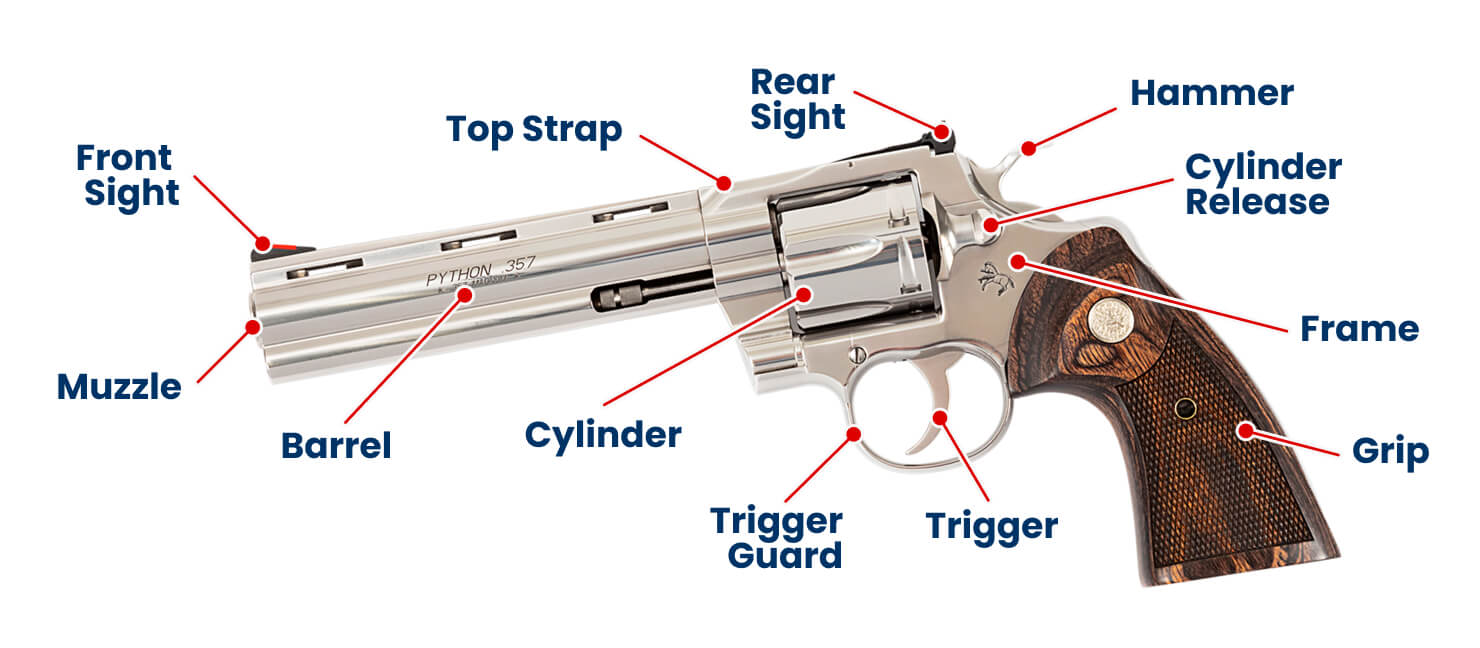
Cylinder
The cylinder is a key part of a revolver. It holds the bullets and rotates to line up each shot. This part makes the revolver different from other guns. It allows multiple shots without reloading after every shot.
Chambers And Capacity
The cylinder has several chambers. Each chamber holds one bullet. Most revolvers have five or six chambers. Some models can hold more or fewer bullets. The number of chambers limits how many shots you can fire before reloading.
The chambers are evenly spaced around the cylinder. This design helps the cylinder rotate smoothly. It also keeps the gun balanced when firing multiple shots.
Cylinder Rotation Mechanism
The cylinder rotates to bring a new chamber in line with the barrel. This movement happens each time you pull the trigger or cock the hammer. The rotation is controlled by a part called the hand or pawl.
The hand pushes the cylinder to the next position. It locks the cylinder in place to make sure the bullet lines up perfectly. This precise alignment is important for safety and accuracy.
Hammer
The hammer is a key part of a revolver that strikes the firing pin to shoot a bullet. It moves back and forth when you pull the trigger. This small piece helps start the firing process quickly and safely.
The hammer is a key part of a revolver. It controls the firing of the bullet. When the trigger is pulled, the hammer strikes the firing pin. This action ignites the cartridge and fires the bullet.
The hammer also helps cock the gun, making it ready to shoot. You can see and feel the hammer on most revolvers. It often has a textured surface for better grip.
Single Action Vs Double Action
Single action revolvers need the hammer to be pulled back manually. This action cocks the gun. Pulling the trigger then releases the hammer to fire the bullet. It requires two steps to shoot.
Double action revolvers let you pull the trigger to cock and fire the gun in one step. The hammer moves back and hits the firing pin when you pull the trigger. This makes double action faster to use.
Single action guns offer lighter trigger pulls but slower firing. Double action guns provide quicker shots but heavier trigger pulls.
Hammer Spur
The hammer spur is the small, raised part at the end of the hammer. It gives you a place to grip and pull the hammer back. This is important for single action revolvers.
The spur often has grooves or textures for better hold. It lets you cock the hammer easily with your thumb. Some revolvers have smaller or no spurs for safety or design reasons.
The hammer spur affects how quickly and comfortably you can ready the gun to fire. It plays a big role in the gun’s handling and control.
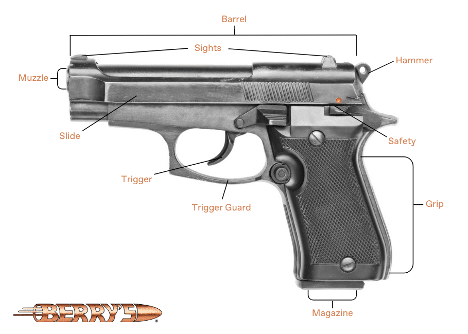
Trigger
The trigger is a key part of a revolver. It controls when the gun fires. Pulling the trigger releases the hammer or striker. This action lets the bullet leave the barrel. The trigger must work smoothly for safe and accurate shooting.
Trigger Pull
Trigger pull means the force needed to pull the trigger. A light trigger pull helps with better aim. A heavy pull can make the shooter lose control. Some revolvers have adjustable trigger pull weight. This lets users set their preferred pull strength.
Trigger Guard
The trigger guard is a protective loop around the trigger. It stops accidental pulls that could cause harm. The guard also helps the shooter keep their finger in place. It adds safety and control during handling. Every revolver has a trigger guard for these reasons.
Sights
The sights on a revolver help you aim at your target. They guide your eyes to line up the gun correctly. Good sights make shooting more accurate and confident.
Sights come in different styles and designs. Each has a purpose to improve your aim.
Front And Rear Sights
The front sight is a small post near the gun’s muzzle. It is the main point you focus on when aiming. The rear sight sits closer to your eye. It usually has a notch or a small window.
Align the front sight inside the rear sight notch. This creates a straight line to the target. Proper alignment helps hit the target more precisely.
Adjustable Sights
Adjustable sights allow changes in windage and elevation. Windage moves the sight left or right. Elevation moves it up or down.
This adjustment helps shooters fine-tune their aim. It is useful for different shooting distances or conditions. Many target shooters prefer adjustable sights for better control.
Other Components
Besides the main parts of a revolver, there are other important components. These parts help the revolver work smoothly and safely. Understanding them gives a clearer picture of how this firearm operates.
Ejector Rod
The ejector rod pushes out spent cartridges from the cylinder. After firing, the empty shells stay inside the chambers. The shooter presses the ejector rod to remove these shells quickly. This makes reloading faster and easier.
Loading Gate
The loading gate covers the cylinder’s loading area. It opens to allow bullets to enter the chambers. When closed, it keeps the bullets safe inside. The gate also protects the cylinder from dirt and damage.

Frequently Asked Questions
What Are The Main Parts Of A Revolver?
A revolver’s main parts include the barrel, cylinder, frame, hammer, and grip. Each part plays a specific role in firing and handling the firearm safely.
How Does The Cylinder Function In A Revolver?
The cylinder holds multiple cartridges and rotates with each trigger pull. This rotation aligns a new round with the barrel, readying the gun to fire.
What Role Does The Hammer Play In A Revolver?
The hammer strikes the firing pin or cartridge primer, igniting the gunpowder. This action causes the bullet to discharge from the barrel.
Why Is The Barrel Important In A Revolver?
The barrel directs the bullet when fired. It stabilizes the bullet’s path, improving accuracy and controlling the projectile’s speed.
Conclusion
A revolver has many parts that work together. Each part has a clear job to do. Knowing these parts helps you understand how it works. The barrel, cylinder, hammer, and trigger are key pieces. This knowledge can make handling a revolver safer and easier.
Remember, every part matters in making the gun function well. Keep learning about firearms to stay informed and confident. Understanding basics is the first step to responsible use.

